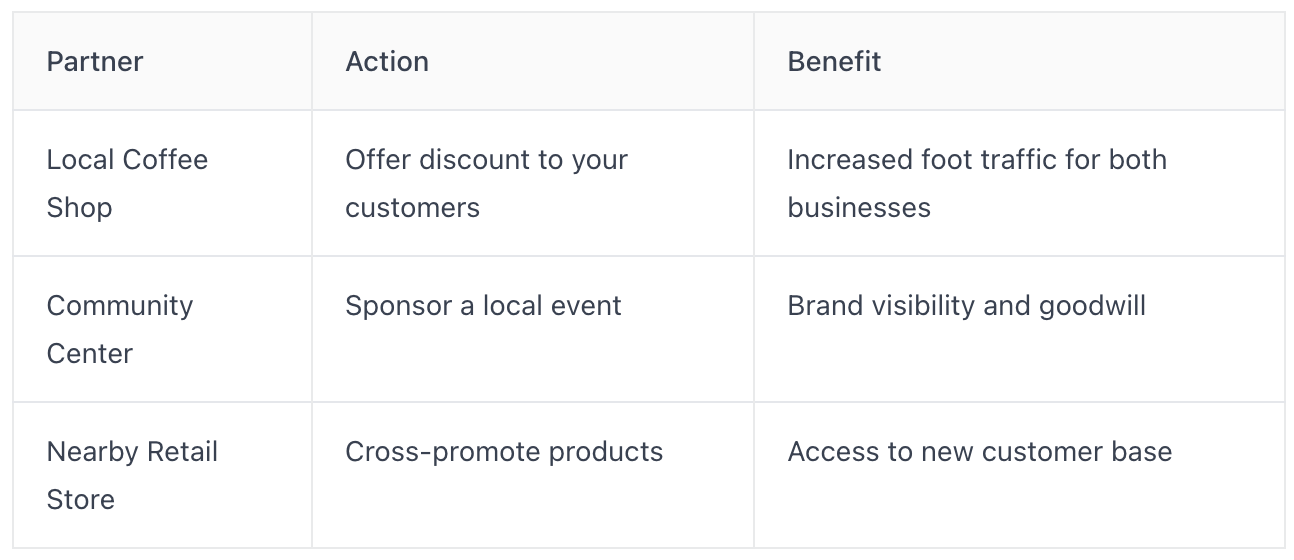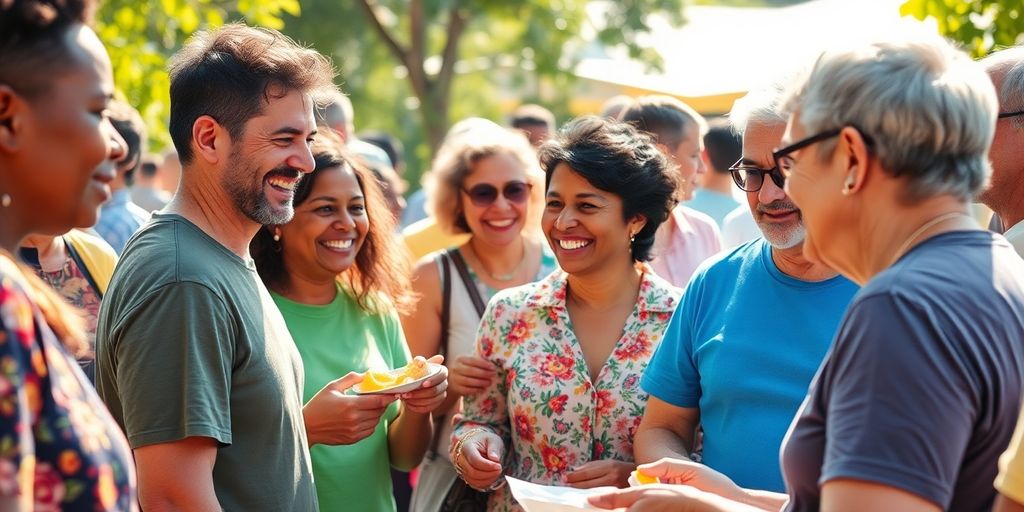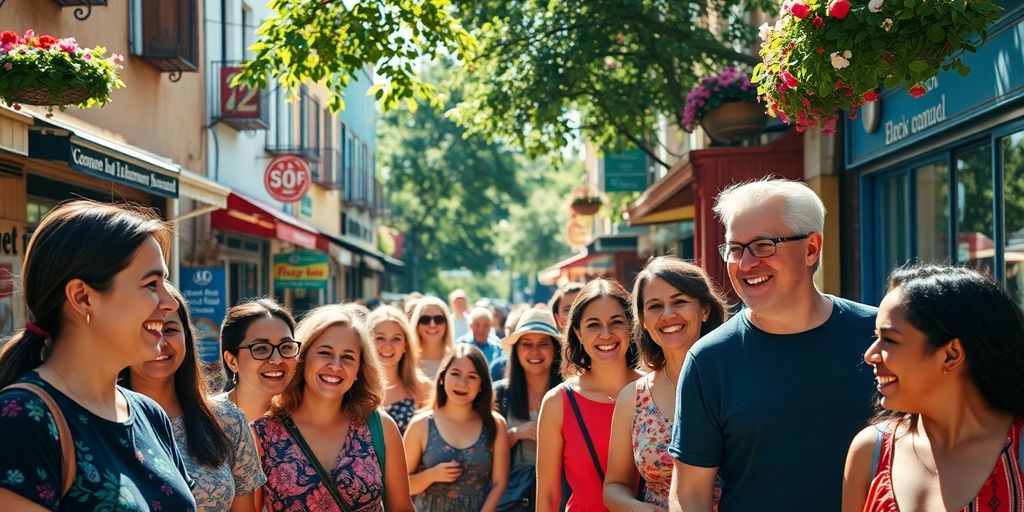Register as an organizer
Click the button below and finish your organizer registration, or fill out the form and we will be in touch to assist you.

More and more, businesses are seeing how important it is to connect with the people right around them. It’s not just about selling stuff; it’s about becoming a real part of the neighborhood. This approach, called community-first branding, can really help a business grow and keep customers coming back. When a brand focuses on its local community, it builds strong ties, earns trust, and creates a loyal following. Let's look at how this works and why it matters, especially for community-first event branding.
What exactly is a local brand? It's more than just a business with a physical location in your town. It's about a business deeply intertwined with the community's identity. A true local brand understands the unique needs, values, and aspirations of the people it serves. Think of the corner bakery that knows everyone's name or the hardware store that sponsors the little league team. These brands aren't just selling products; they're selling a sense of belonging and shared experience.
Global brands aim for universal appeal, often standardizing their products and marketing across different regions. Local brands, on the other hand, thrive on differentiation. They celebrate the unique aspects of their community, tailoring their offerings and messaging to reflect local culture and preferences. It's the difference between a chain restaurant serving the same menu everywhere and a family-owned diner featuring locally sourced ingredients and regional specialties. Local brands prioritize personal connections and community involvement over mass-market reach.
Why does localism matter? People are increasingly seeking authentic experiences and meaningful connections. They want to support businesses that give back to their communities and share their values. Local brands can tap into this desire by:
By embracing localism, brands can build stronger customer loyalty, enhance their reputation, and drive sustainable growth. It's about becoming an integral part of the community fabric, not just another business operating within it.
Okay, so you want people to actually care about your brand, right? It's not just about slapping a logo on something and calling it a day. It's about getting involved. Think about sponsoring the local little league team, or hosting a booth at the town fair. The goal is to show up where the people are. It's about being present and supportive. Reach out to other businesses too. Maybe you can do a cross-promotion with the bakery down the street or partner with the hardware store for a community event.
Every town has its own vibe, its own quirks. Don't try to force your brand to be something it's not. Instead, celebrate what makes the community unique. Is there a local artist whose work you can feature? A historical landmark you can highlight? Use local slang in your marketing (but, like, do it right). People can spot a phony from a mile away.
People want to feel good about where they live. Your brand can play a part in that. Support local initiatives, like park cleanups or food drives. Highlight the positive aspects of the community. Show that you're not just there to make a buck, but that you actually care about the place and the people. Think about how your brand can contribute to the overall well-being of the community. Maybe you can offer a scholarship to a local student or donate a portion of your profits to a local charity. It's about building community and making a positive impact.
It's not enough to just say you're local. You have to be local. That means understanding the values, the traditions, and the aspirations of the community. It means being a good neighbor and a responsible citizen. It means putting people before profits. When you do that, you'll earn the trust and loyalty of the community, and that's something that no amount of advertising can buy.
To really make an impact, you can't just guess what people want. You need to do some serious digging. Local market research local marketing strategies means understanding the specific needs, preferences, and quirks of your target area. It's about getting to know your neighbors, not just seeing them as potential customers. This involves surveys, focus groups, and even just hanging out at local spots to get a feel for the vibe. It's more than demographics; it's about understanding the culture.
Once you know your audience, you need to speak their language. This isn't just about translating your existing ads; it's about crafting messages that feel authentic and relevant to the local community. Think about the tone, the imagery, and the values you're communicating. A message that kills in New York might flop in a small town in Iowa. It's about making your brand feel like it belongs there.
Don't try to do it all alone. Partnering with other local businesses can be a game-changer. It's about finding businesses that complement yours and working together to reach a wider audience. Think about cross-promotions, joint events, or even just recommending each other to your customers. It's about building a network and supporting each other. These local partnerships can really boost your visibility.
Building relationships with other local businesses is a great way to get your name out there. It shows you're invested in the community and willing to work with others to make it better. It's a win-win for everyone involved.
Here's a simple example of how partnerships can boost reach:

Here are some ways to form partnerships:

Communities stick with brands that make them feel part of the story. By showing up where people live, listen, and act on what they say, a local brand can turn casual buyers into true supporters.
Get out from behind the screen. Attend local fairs, sponsor a little league team, or host a casual meet-up at a coffee shop. People notice when you’re around and genuinely interested.
These steps help you blend in, learn what matters, and earn goodwill over time.
A community that feels seen will stick with you for the long haul. Start by listening first, then follow up fast. When someone raises a concern or asks a question, a quick answer tells them you care.

A few easy wins:
Deliver on your word, every single time. Show up, stick to quality, and be open about what you do and don’t know. That kind of transparency turns first-time buyers into word-of-mouth fans.
When people trust you, they talk about you – often to friends who’ve never even heard of your brand.
Keep your promises, admit mistakes, and fix them fast. Over time, your name will carry weight around town.
Going local can seriously cut down on your marketing spend. Instead of throwing money at broad, national campaigns, you're focusing on a smaller, more defined area. Word-of-mouth spreads like wildfire in close-knit communities, and that's free advertising you can't buy. Plus, you can get creative with local events and sponsorships that don't break the bank. It's about being smart, not just loud.
Community-first branding is all about making real connections. It's not just about selling stuff; it's about becoming a part of people's lives. When you're involved in local events, supporting local causes, and actually listening to what people have to say, you build trust. And trust is the foundation of any good relationship, business or otherwise. People are more likely to support a brand they feel connected to.
Social media is a powerful tool, especially when you're targeting a local audience. You can run targeted ads, share local news and events, and engage with customers on a personal level. It's about being present and responsive. When people see you're actively involved in the community, they're more likely to follow you, share your content, and become loyal customers. It's a two-way street, not just a megaphone.
Focusing on community engagement can lead to more authentic interactions online. People appreciate seeing a brand that cares about more than just profits. It's about building a digital community that reflects the real-world community you're serving.

Community engagement isn't just about traditional marketing; it's about finding new ways to connect. Think outside the box and explore alternative channels to reach your target audience.
These avenues can expose your brand to people who might not see your ads online. It's about being present where your community already is.
When the economy takes a hit, loyal customers are your best defense. A strong community provides a buffer against economic downturns. People are more likely to support businesses they feel connected to, even when money is tight.
A community-first approach builds resilience. It's not just about sales; it's about creating relationships that last. These relationships provide stability when the market is volatile.
Community engagement can breathe new life into your brand and products. By listening to your community, you can adapt and innovate to meet their evolving needs. This keeps your brand relevant and extends its lifespan. Consider personalized customer interactions to keep your customers engaged.
Here's how:
It's not enough for a brand to say it cares about the community; that sentiment needs to run deep within the company culture. The most successful community-first event brands are those where employees genuinely believe in the mission and values being promoted. When internal pride aligns with the external promise, the authenticity shines through, making the brand more relatable and trustworthy.
Authenticity is key. People can spot a phony campaign from a mile away. To create powerful and authentic campaigns, brands need to:
Community-first event branding isn't just about slapping a logo on a local event. It's about building genuine relationships and creating shared experiences that leave a lasting positive impact.
Community-first event branding is an ongoing process, not a one-time thing. It's about building momentum over time, creating meaning for both the brand and the community, and sparking a little bit of magic along the way. Think of it as a long-term investment in building relationships and fostering goodwill. When done right, it can lead to increased brand loyalty, positive word-of-mouth, and a stronger connection to the local community.
So, what's the big takeaway here? It's pretty simple: if you want people to stick with your brand, you've got to be part of their world. Brands that really get their local community, that speak their language and show they care, those are the ones that win. It's not about being the biggest; it's about being real and connecting with folks right where they are. When a brand feels like it belongs, like it's one of us, that's when you build something special that lasts.
A local brand is a business that mostly serves a small area, like a specific city or region. It focuses on the people who live there, making sure its products and messages fit that community well. Unlike big global brands, local brands often have a single owner and work closely with other nearby businesses.
Local brands are different because they aim to serve a specific group of people in a smaller area. They care more about making things just right for their local customers than selling a lot everywhere. They often focus on high quality and a great experience, speaking to their community in a way that feels natural and personal. They become a part of the local culture.
Building a local brand has many good points. It can be cheaper to start because you don't need to reach everyone. It's also easier to make friends with other local businesses and build strong relationships with customers. This helps earn trust and loyalty, and it can make your business look more reliable and trustworthy.
To build a strong local brand, you should first study the local people to understand what they like and need. Then, make sure your brand's message speaks directly to them in a way they understand. Also, working with other local businesses can help you reach more people and offer better things to customers.
Being a local brand means you can really get to know your customers. You can talk to them directly, understand their daily lives, and make them feel like they're part of your business. This helps build strong bonds and trust, making customers more likely to stick with you and tell their friends about you.
Yes, local brands are very important today because people care more about their local communities. They want to support businesses that understand their area and contribute to it. This means local brands can grow by focusing on what makes their community special and by becoming a valued part of it.
More blogs
Click the button below and finish your organizer registration, or fill out the form and we will be in touch to assist you.